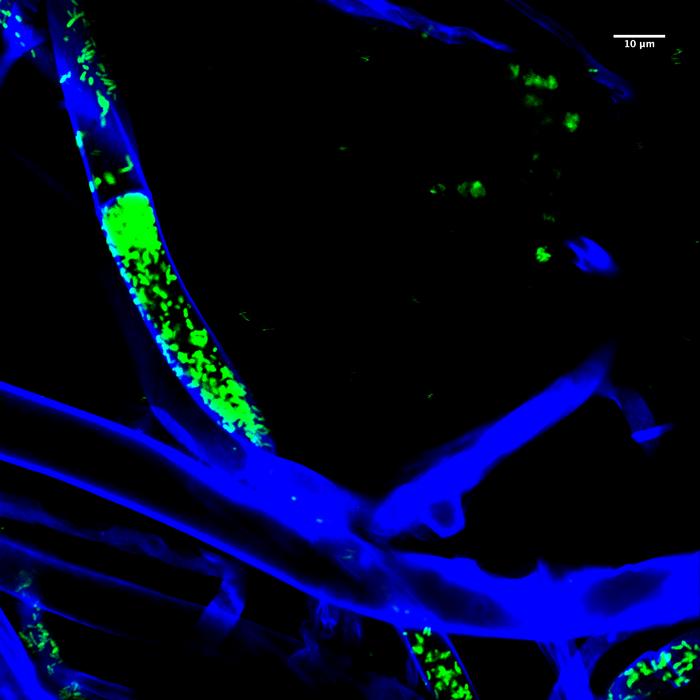A new study on the coexistence of bacteria and fungi shows that a mutually beneficial, functioning symbiosis can be very fragile. Researchers at the Leibniz Institute for Natural Product Research and Infection Biology (Leibniz-HKI) in Jena found out that the bacterial species Mycetohabitans rhizoxinica lives happily in the hyphae of the fungus Rhizopus microsporus only when the bacteria produce a certain protein.

Credit: Ingrid Richter/Leibniz-HKI
A new study on the coexistence of bacteria and fungi shows that a mutually beneficial, functioning symbiosis can be very fragile. Researchers at the Leibniz Institute for Natural Product Research and Infection Biology (Leibniz-HKI) in Jena found out that the bacterial species Mycetohabitans rhizoxinica lives happily in the hyphae of the fungus Rhizopus microsporus only when the bacteria produce a certain protein.
In a symbiosis, two organisms join together and benefit from each other; in endosymbiosis, one of the organisms takes this strategy further to live within the other. In some cases, they can’t do without each other, like the fungus Rhizopus microsporus and the bacterium Mycetohabitans rhizoxinica (previously known as (Para)burkholderia rhizoxinica). The fungus can cause rice seedling blight, which leads to enormous crop losses in Asia every year. However, R. microsporus can only do this with M. rhizoxinica: the bacterium produces a plant toxin that is processed and released by the fungus. Without the bacterium, the fungus can no longer form spores and spread efficiently. In return, it supplies its endosymbiont with nutrients.
“In the wild, the two always live in symbiosis,” explains Ingrid Richter, a postdoctoral researcher in the Department of Biomolecular Chemistry at Leibniz-HKI. In the laboratory, however, the researchers have succeeded in cultivating them separately. “As a result, we know that the bacteria are still able to infect the fungus,” Richter said.
From parasitism to symbiosis?
The research team now found that a specific bacterial protein, or more precisely an effector protein, maintains the symbiosis. If the researchers deactivate the so-called TAL effector 1 (MTAL1), the bacteria multiply uncontrollably, and the fungus, as a result, closes off parts of its hyphae with new cell walls. The now-trapped bacteria subsequently die. “These TAL effectors are known from various plant-infecting bacteria,” Richter said, where they allow the bacteria to invade plant cells.
In the case of R. microsporus and M. rhizoxinica, an initially parasitic relationship may have changed to a symbiotic one. Indeed, if the effector protein is not present, the bacteria can continue to infect the fungus – that is, they “melt” the cell wall and penetrate the fungal hyphae. However, they are then perceived as parasitic by the fungus. Only when the TAL effector is present is the symbiosis stable. “This shows the smooth transition between a symbiosis that benefits both partners and a possibly parasitic relationship that can be detrimental to one partner,” Richter said.
Close microscopic observation
To be able to observe the infection process more closely, the researchers have developed a sophisticated system: they grow the fungus in microfluidic chips with very narrow channels. In one channel, there is only space for a single fungal hypha. Afterwards they add the bacteria and observe the infection process under a microscope for several hours. “Because of the design, the filamentous hyphae don’t grow on top of each other, so we can see exactly what’s happening,” Richter explains. For example, she was able to show that the fungus builds up additional transverse walls in the hyphae when the TAL effector is switched off – and that there are particularly large numbers of bacteria in the areas separated in this way. “Using certain dyes, we can see that the trapped bacteria die after a few hours.”
The researchers now want to further investigate the cellular processes that are triggered by the effector protein. “We suspect that the TAL effector binds in the fungal genome, because that is typical for these proteins – but we don’t know where,” Richter said. One reason is that the genome of R. microsporus has not yet been fully decoded.
The research results provide new insights into endosymbiotic partnerships that play a major role in evolution. For example, today’s mitochondria, the energy providers in plant, animal, and fungal cells, were probably originally endosymbionts. They have their own DNA, but have long been unable to survive independently – unlike M. rhizoxinica. “In addition, through close microscopic observation, we have learned quite a bit about what tasks different types of hyphae have in the fungal mycelium, for example, the transport of nutrients,” Richter explains.
The research work was supported by the EU under a Marie Skłodowska-Curie grant for Ingrid Richter, by the German Research Foundation under the Balance of the Microverse Cluster of Excellence, the ChemBioSys Collaborative Research Center, the Jena School for Microbial Communication, the Leibniz Prize for the study leader Christian Hertweck, and by the Swiss National Science Foundation.
Journal
Current Biology
DOI
10.1016/j.cub.2023.05.028
Method of Research
Experimental study
Subject of Research
Cells
Article Title
Transcription activator-like effector protects bacterial endosymbionts from entrapment within fungal hyphae
Article Publication Date
9-Jun-2023




